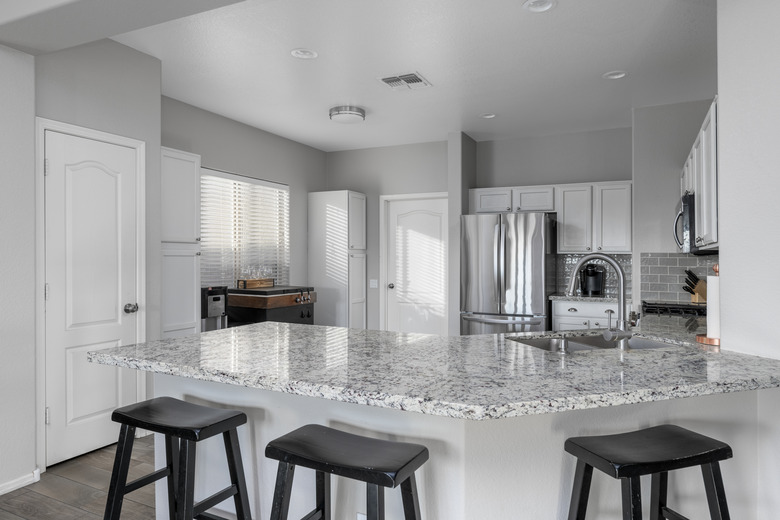How To Fix The Gap Between The Kitchen Countertop And The Wall
When you install a vanity or floor cabinet, some kind of gap between the counter and the wall or backsplash is almost inevitable. Even if you manage to get the cabinet tight enough against the wall to make this gap unnoticeable, movements in the wall or the cabinet may open one up later. Moreover, it's common for walls to be slightly askew, especially in older homes. Gap width can vary from one side of the countertop to the other. The two options for hiding the space include caulking it and covering it with trim.
Close the Gap Between Counter and Wall
Close the Gap Between Counter and Wall
If the gap between the countertop and backsplash is more than 3/8 inch, it's generally too wide to fill and is best handled with trim, but you can try to close the gap to give yourself the caulk option. You'll need a drill with a No. 2 Phillips bit, a flat pry bar, wood shims, and a hammer.
Raise the Cabinets to Close the Gap
Raise the Cabinets to Close the Gap
Locate the screws holding the cabinet to the wall, which are inside the cabinet near the top. You should find two, three or more driven through the reinforcement strip that supports the back of the countertop. Back out all the screws, using a drill and a No. 2 Phillips bit, and remove them.
Insert a flat bar under the toe kick of the cabinet and pry up the front of the unit to push the countertop closer to the wall. You may not be able to raise the front much, but sometimes you can raise it 1/2 inch or more. Insert wood shims under the toe kick to keep the cabinet in this position.
Drive the screws into the new holes and sink them into the wall studs as far as they'll go without over-tightening them. Check the shims after refastening the cabinet to the wall. They may be loose because the screws lifted the cabinet slightly; if so, replace them with slightly thicker ones that you have to tap in with a hammer.
Caulking the Gap
Caulking the Gap
If you can reduce the gap to 1/4 inch or less, you'll be able to fill it with acrylic latex or silicone caulk. If the gap is wider, stuff some backer rod in first. This is foam beading that supports the caulk and prevents it from sinking and forming voids. It's sometimes a good idea to install it just before you close the gap by unscrewing the cabinet, shimming it, and screwing it back to the studs. You can also stuff it into the gap without removing the cabinet with a putty knife.
Caulking Procedure
Caulking Procedure
Lay painter's tape along the edge of the countertop and the wall just above the gap to keep caulk off these surfaces. Apply the caulk with a caulking gun. Choose a color that matches the countertop and spread a thin, continuous bead with no voids.
Tool the caulk by drawing your finger along it to form a concave surface. Remove the tape carefully before the caulk sets.
The Trim Option
The Trim Option
If there is an unusually irregular or large gap between the countertop and wall, you may not have an option other than to cover it with trim; you may even prefer this option. Common trim choices for this purpose include quarter-round and cove molding as well as rectangular 1-by-2-inch material. Tips for installing trim on a countertop include:
- Prime or seal the molding after you've cut and finished it but before you install it.
- Glue the molding to the countertop or the wall with a thin layer of construction adhesive. Avoid nails; they can damage the countertop.
- Caulk both edges of the trim with acrylic latex caulk.
- Apply a single coat of paint or finish after the caulk sets.
